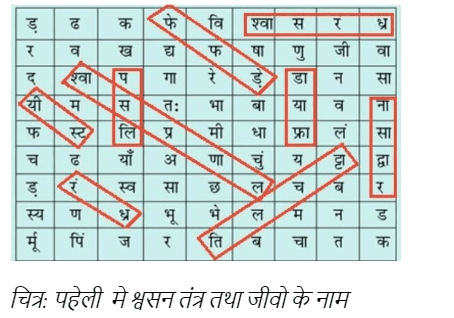NCERT Solutions for Class 7 Science Chapter 10 Respiration in Organisms In Hindi PDF Download
FAQs on NCERT Solutions for Class 7 Science Hindi Chapter 10 Respiration In Organisms
1. Why does an athlete breathe faster and deeper than usual after finishing the race?
The body movements that are made when an athlete exercises or runs increase the body’s requirement for oxygen. This is because the organs need more oxygen to produce the energy needed to perform the tasks or exercises. And similarly, after the athlete has finished running, more carbon dioxide is required for expiration. This leads to a higher rate of breathing and faster and deeper breathing than usual by the athlete after finishing the race.
2. Why do we often sneeze when we inhale a lot of dust-laden air?
Our nostrils contain hair that stops the dust particles in the air from entering our respiration system any further. When the air we inhale contains dust particles, these particles are trapped in the nostril hair. But when these particles of dust pass through the hair present in our nostrils and reach the nasal cavity, the mucus lining present there gets irritated by these particles. As a reaction from our body, we sneeze. To know more students can download the free PDF of NCERT Solutions of Class 7 Science.
3. What are the similarities between aerobic and anaerobic respiration according to Chapter 10 of NCERT Solutions for Class 7 Science?
The following are some similarities between anaerobic and aerobic respiration as discussed in NCERT Solutions for Class 7 Science Chapter 10 - Respiration in Organisms:
Both kinds of respiration produce Adenosine triphosphate or ATP.
Glucose is used as the starting molecule by both types of respiration.
Both aerobic respiration and anaerobic respiration take place inside the cells of the body.
4. What is Chapter 10 of Class 7 Science in NCERT Solutions about?
Chapter 10 - Respiration in Organisms in NCERT Solutions for Class 7 Science discusses various details about how respiration works in different kinds of organisms that are around us. The chapter begins with a discussion on why and how respiration takes place in the human body, the respiratory process in other animals like cockroaches and earthworms, and the working of respiration in animals who survive underwater. In the end, the chapter also talks about the respiratory process in plants.
5. Do I need to practice all the questions provided in Chapter 10 of Class 7 Science NCERT Solutions?
NCERT Solutions are a very helpful source for students while preparing for their Class 7 Science exams. Your teachers frame the question papers based on the NCERT Books. Hence, many of the NCERT Questions can directly or indirectly appear in your exam. Since it cannot be known which questions exactly can be asked in the paper, it is crucial that you practice all the questions covered in the NCERT Solutions. This will only make your preparation stronger and better. All the study material is also available on the vedantu app.























